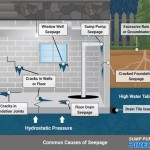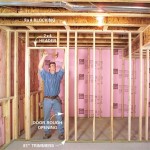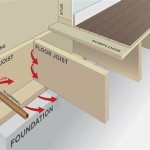Why Is My Sump Pump Flooding My Basement?
A sump pump's primary function is to prevent basement flooding by collecting water accumulating around the foundation and diverting it away from the property. When a basement experiences flooding despite having a sump pump, it indicates a malfunction or inadequacy within the system. Identifying the underlying cause is crucial for implementing effective corrective measures and preventing future water damage.
Several factors can contribute to a sump pump's failure to effectively manage groundwater, resulting in basement flooding. These reasons range from mechanical issues with the pump itself to environmental factors impacting the volume of water requiring drainage. A systematic approach to diagnosing the problem is essential for accurate troubleshooting.
Pump Malfunction or Failure
The most direct cause of a sump pump's failure to prevent flooding is a malfunction within the pump itself. Several mechanical or electrical problems can lead to this issue. One common problem is a burnt-out motor. Sump pumps, like all electrical appliances, have a finite lifespan, and frequent use or age can lead to motor failure. Over time, the motor's components can deteriorate, causing it to overheat and eventually stop functioning. Regular inspection and maintenance can help identify signs of wear and tear before complete failure occurs.
Another potential problem lies in the float switch. The float switch is responsible for activating the sump pump when the water level in the sump pit reaches a certain point. A malfunctioning float switch can prevent the pump from turning on, even when water is accumulating rapidly. Debris, such as sediment or small objects, can obstruct the float switch's movement, preventing it from rising and triggering the pump. In some cases, the float switch itself may be damaged, requiring replacement.
The impeller, the component responsible for physically moving water, can also become clogged or damaged. Sediment, gravel, or other debris can enter the sump pit and become lodged in the impeller, reducing its efficiency or stopping it completely. Physical damage to the impeller, such as cracks or breaks, can also impair its ability to move water effectively. Regular cleaning of the sump pit can help prevent impeller blockages, and periodic inspection can reveal any signs of damage.
Furthermore, electrical issues can prevent the pump from operating. A tripped circuit breaker or a power outage can obviously render the pump inoperable. The sump pump's electrical cord can also be damaged, leading to short circuits or a complete loss of power. Properly grounding the sump pump and ensuring a dedicated circuit can help prevent electrical problems. Using a battery backup system can provide power during outages.
Finally, the check valve could be malfunctioning. The check valve, situated in the discharge pipe, prevents water from flowing back into the sump pit after the pump has shut off. If the check valve is faulty or clogged, water will drain back into the pit, causing the pump to cycle on and off more frequently and potentially leading to overheating and failure. A malfunctioning check valve can also contribute to increased water levels in the basement if the pump cannot keep up with the backflow.
Inadequate Pump Capacity
Even a fully functional sump pump may be unable to prevent flooding if its capacity is insufficient for the volume of water accumulating around the foundation. Sump pump capacity is measured in gallons per hour (GPH), and the appropriate GPH rating depends on several factors, including the size of the basement, the depth of the water table, and the amount of rainfall in the area. If the pump's GPH rating is too low, it will be unable to keep pace with the inflow of water during periods of heavy rain or snowmelt.
An undersized sump pump may have been adequate at the time of installation but may no longer be sufficient due to changes in the surrounding environment. New construction or landscaping projects in the vicinity can alter drainage patterns, increasing the amount of water directed toward the property. Also, older homes may have aging weeping tile systems that are becoming less effective at channeling water away from the foundation.
The depth of the sump pit itself can also play a role in pump performance. A shallow sump pit will fill up more quickly, causing the pump to cycle on and off more frequently. Frequent cycling can shorten the pump's lifespan and reduce its overall efficiency. A deeper sump pit provides a larger reservoir for water accumulation, allowing the pump to operate less frequently and more efficiently. The depth of the sump pit should be appropriate for the size of the basement and the expected water inflow.
Selecting the correct GPH rating requires careful consideration of these factors. Consulting with a plumbing professional can help determine the appropriate pump size for a specific property. Upgrading to a higher-capacity pump may be necessary if the existing pump is consistently struggling to keep up with the water inflow.
Another aspect to consider is the horsepower (HP) of the pump. While GPH indicates the flow rate, HP indicates the pump's power and its ability to lift water vertically. If the discharge pipe has a significant vertical rise, a pump with a higher HP rating may be required to effectively move water away from the foundation. Failure to account for the vertical lift can significantly reduce the pump's effective GPH.
Drainage Issues and External Factors
The effectiveness of a sump pump is also dependent on the proper functioning of the surrounding drainage system and the presence of external factors that can contribute to excessive water accumulation. Problems with the weeping tile system, which is designed to collect groundwater around the foundation, can significantly impact the performance of the sump pump. Clogged or damaged weeping tiles can prevent water from reaching the sump pit, causing it to pool around the foundation and potentially seep into the basement through cracks in the walls or floor.
The discharge pipe, which carries water away from the sump pump, must also be free of obstructions and properly sloped. If the discharge pipe is clogged with debris, frozen, or improperly sloped, it can restrict the flow of water, causing it to back up into the sump pit and potentially overflow into the basement. Proper grading around the foundation is also crucial for diverting surface water away from the property. If the ground slopes toward the house, rainwater will tend to accumulate near the foundation, increasing the burden on the sump pump.
Heavy rainfall or snowmelt can overwhelm even a properly functioning sump pump if the volume of water exceeds its capacity. Prolonged periods of heavy precipitation can saturate the ground, leading to a significant increase in groundwater levels. In such cases, the sump pump may be running continuously and still be unable to prevent flooding. Addressing surface water drainage issues, such as installing gutters and downspouts or improving the grading around the foundation, can help reduce the amount of water reaching the sump pit.
Another contributing factor can be a high water table. The water table is the upper surface of groundwater. Areas with a naturally high water table are more prone to basement flooding, as the groundwater level may be close to or even above the level of the basement floor. In these cases, the sump pump may need to operate almost continuously to maintain a dry basement. The effectiveness of the sump pump can be enhanced by improving drainage around the foundation and ensuring that the weeping tile system is functioning properly.
Furthermore, cracks and leaks in the foundation walls or floor can allow water to enter the basement directly, bypassing the sump pit altogether. These cracks can be caused by settling, hydrostatic pressure, or other factors. Sealing these cracks can help reduce the amount of water entering the basement and alleviate the burden on the sump pump. Professional foundation repair services can provide effective solutions for sealing cracks and preventing water infiltration.
Improper installation of the sump pump itself can also lead to problems. If the sump pump is not properly positioned in the sump pit, it may not be able to effectively collect water. The pump should be placed on a solid, level surface to prevent it from tipping over or vibrating excessively. The discharge pipe should be securely connected to the pump and properly routed away from the foundation. Consulting with a qualified plumber during installation can help ensure that the sump pump is properly installed and will function effectively.
Finally, routine maintenance is essential for ensuring the long-term performance of the sump pump. Regular cleaning of the sump pit, inspection of the pump and its components, and testing of the float switch can help identify and address potential problems before they lead to flooding. Replacing the sump pump every 5-7 years, even if it appears to be functioning properly, can help prevent unexpected failures and ensure continued protection against basement flooding. A well-maintained sump pump is a crucial component of a comprehensive basement waterproofing strategy.

Here S Why Your Basement Flooded Even When You Have A Sump Pump Forbes Home

What To Do When Sump Pump Failure Leads Basement Flooding

How To Not Flood Your Basement A Guide Sump Pump System Home Inspection Geeks

Excessive Flooding And Sump Pump Failures Safety Tips

Do You Know What Your Sump Pump Is Doing Tom S Basement Waterproofing Inc

Stop Basements Flooding Flood Prevention Pumps Alarms Ecohome

3 Irritating Reasons Sump Pumps Fail Ashworth Drainage

How Sump Pumps Help Keep Your Basement Dry Encompass

5 Facts About Sump Pumps You Need To Know Plumber In Paso Robles Ca

What To Do With Your Sump Pump During A Power Outage The Basement And Co







